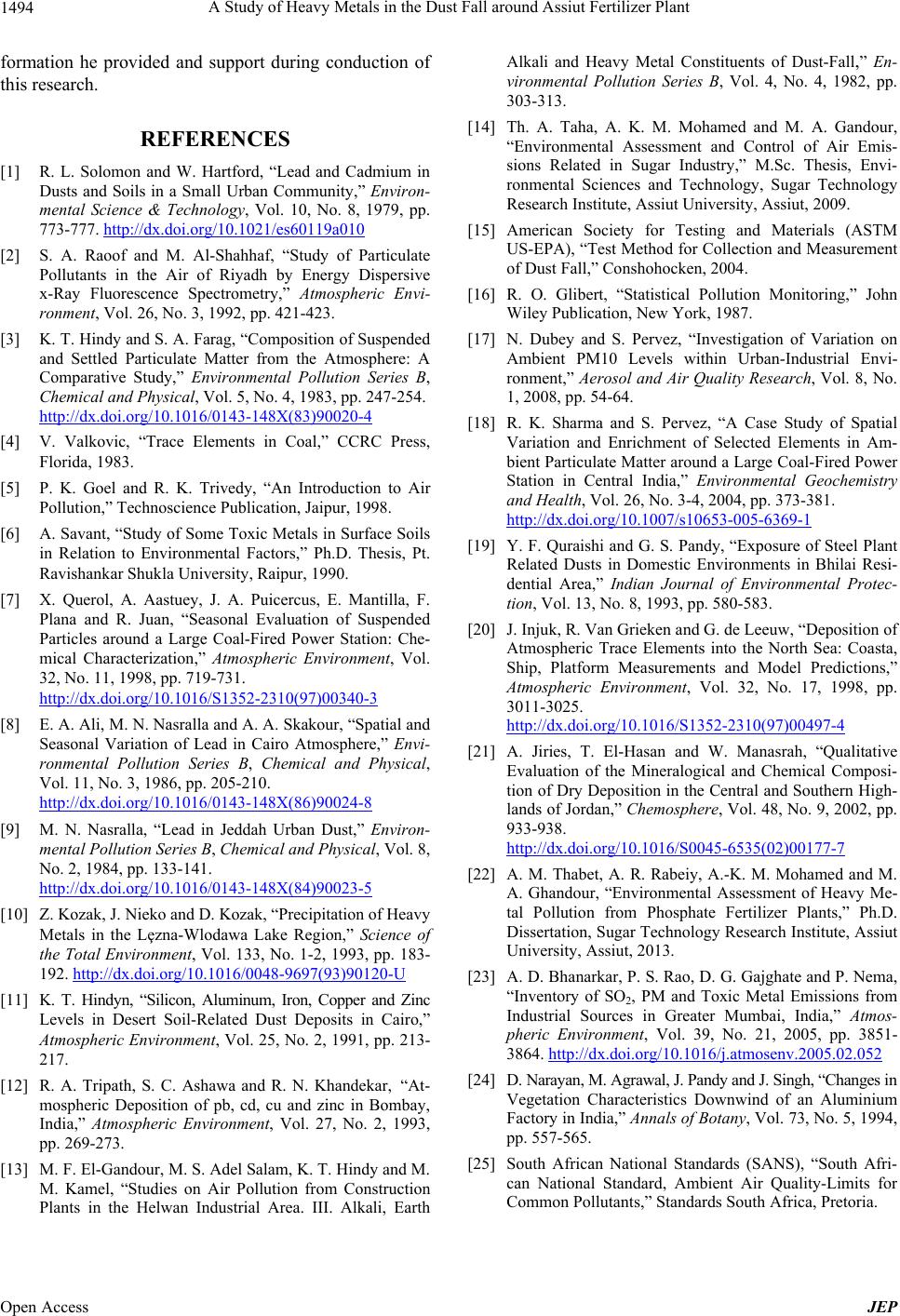
A Study of Heavy Metals in the Dust Fall around Assiut Fertilizer Plant
Open Access JEP
1494
formation he provided and support during conduction of
this research.
REFERENCES
[1] R. L. Solomon and W. Hartford, “Lead and Cadmium in
Dusts and Soils in a Small Urban Community,” Environ-
mental Science & Technology, Vol. 10, No. 8, 1979, pp.
773-777. http://dx.doi.org/10.1021/es60119a010
[2] S. A. Raoof and M. Al-Shahhaf, “Study of Particulate
Pollutants in the Air of Riyadh by Energy Dispersive
x-Ray Fluorescence Spectrometry,” Atmospheric Envi-
ronment, Vol. 26, No. 3, 1992, pp. 421-423.
[3] K. T. Hindy and S. A. Farag, “Composition of Suspended
and Settled Particulate Matter from the Atmosphere: A
Comparative Study,” Environmental Pollution Series B,
Chemical and Physical, Vol. 5, No. 4, 1983, pp. 247-254.
http://dx.doi.org/10.1016/0143-148X(83)90020-4
[4] V. Valkovic, “Trace Elements in Coal,” CCRC Press,
Florida, 1983.
[5] P. K. Goel and R. K. Trivedy, “An Introduction to Air
Pollution,” Technoscience Publication, Jaipur, 1998.
[6] A. Savant, “Study of Some Toxic Metals in Surface Soils
in Relation to Environmental Factors,” Ph.D. Thesis, Pt.
Ravishankar Shukla University, Raipur, 1990.
[7] X. Querol, A. Aastuey, J. A. Puicercus, E. Mantilla, F.
Plana and R. Juan, “Seasonal Evaluation of Suspended
Particles around a Large Coal-Fired Power Station: Che-
mical Characterization,” Atmospheric Environment, Vol.
32, No. 11, 1998, pp. 719-731.
http://dx.doi.org/10.1016/S1352-2310(97)00340-3
[8] E. A. Ali, M. N. Nasralla and A. A. Skakour, “Spatial and
Seasonal Variation of Lead in Cairo Atmosphere,” Envi-
ronmental Pollution Series B, Chemical and Physical,
Vol. 11, No. 3, 1986, pp. 205-210.
http://dx.doi.org/10.1016/0143-148X(86)90024-8
[9] M. N. Nasralla, “Lead in Jeddah Urban Dust,” Environ-
mental Pollution Series B, Chemical and Physical, Vol. 8,
No. 2, 1984, pp. 133-141.
http://dx.doi.org/10.1016/0143-148X(84)90023-5
[10] Z. Kozak, J. Nieko and D. Kozak, “Precipitation of Heavy
Metals in the Lȩzna-Wlodawa Lake Region,” Science of
the Total Environment, Vol. 133, No. 1-2, 1993, pp. 183-
192. http://dx.doi.org/10.1016/0048-9697(93)90120-U
[11] K. T. Hindyn, “Silicon, Aluminum, Iron, Copper and Zinc
Levels in Desert Soil-Related Dust Deposits in Cairo,”
Atmospheric Environment, Vol. 25, No. 2, 1991, pp. 213-
217.
[12] R. A. Tripath, S. C. Ashawa and R. N. Khandekar, “At-
mospheric Deposition of pb, cd, cu and zinc in Bombay,
India,” Atmospheric Environment, Vol. 27, No. 2, 1993,
pp. 269-273.
[13] M. F. El-Gandour, M. S. Adel Salam, K. T. Hindy and M.
M. Kamel, “Studies on Air Pollution from Construction
Plants in the Helwan Industrial Area. III. Alkali, Earth
Alkali and Heavy Metal Constituents of Dust-Fall,” En-
vironmental Pollution Series B, Vol. 4, No. 4, 1982, pp.
303-313.
[14] Th. A. Taha, A. K. M. Mohamed and M. A. Gandour,
“Environmental Assessment and Control of Air Emis-
sions Related in Sugar Industry,” M.Sc. Thesis, Envi-
ronmental Sciences and Technology, Sugar Technology
Research Institute, Assiut University, Assiut, 2009.
[15] American Society for Testing and Materials (ASTM
US-EPA), “Test Method for Collection and Measurement
of Dust Fall,” Conshohocken, 2004.
[16] R. O. Glibert, “Statistical Pollution Monitoring,” John
Wiley Publication, New York, 1987.
[17] N. Dubey and S. Pervez, “Investigation of Variation on
Ambient PM10 Levels within Urban-Industrial Envi-
ronment,” Aerosol and Air Quality Research, Vol. 8, No.
1, 2008, pp. 54-64.
[18] R. K. Sharma and S. Pervez, “A Case Study of Spatial
Variation and Enrichment of Selected Elements in Am-
bient Particulate Matter around a Large Coal-Fired Power
Station in Central India,” Environmental Geochemistry
and Health, Vol. 26, No. 3-4, 2004, pp. 373-381.
http://dx.doi.org/10.1007/s10653-005-6369-1
[19] Y. F. Quraishi and G. S. Pandy, “Exposure of Steel Plant
Related Dusts in Domestic Environments in Bhilai Resi-
dential Area,” Indian Journal of Environmental Protec-
tion, Vol. 13, No. 8, 1993, pp. 580-583.
[20] J. Injuk, R. Van Grieken and G. de Leeuw, “Deposition of
Atmospheric Trace Elements into the North Sea: Coasta,
Ship, Platform Measurements and Model Predictions,”
Atmospheric Environment, Vol. 32, No. 17, 1998, pp.
3011-3025.
http://dx.doi.org/10.1016/S1352-2310(97)00497-4
[21] A. Jiries, T. El-Hasan and W. Manasrah, “Qualitative
Evaluation of the Mineralogical and Chemical Composi-
tion of Dry Deposition in the Central and Southern High-
lands of Jordan,” Chemosphere, Vol. 48, No. 9, 2002, pp.
933-938.
http://dx.doi.org/10.1016/S0045-6535(02)00177-7
[22] A. M. Thabet, A. R. Rabeiy, A.-K. M. Mohamed and M.
A. Ghandour, “Environmental Assessment of Heavy Me-
tal Pollution from Phosphate Fertilizer Plants,” Ph.D.
Dissertation, Sugar Technology Research Institute, Assiut
University, Assiut, 2013.
[23] A. D. Bhanarkar, P. S. Rao, D. G. Gajghate and P. Nema,
“Inventory of SO2, PM and Toxic Metal Emissions from
Industrial Sources in Greater Mumbai, India,” Atmos-
pheric Environment, Vol. 39, No. 21, 2005, pp. 3851-
3864. http://dx.doi.org/10.1016/j.atmosenv.2005.02.052
[24] D. Narayan, M. Agrawal, J. Pandy and J. Singh, “Changes in
Vegetation Characteristics Downwind of an Aluminium
Factory in India,” Annals of Botany, Vol. 73, No. 5, 1994,
pp. 557-565.
[25] South African National Standards (SANS), “South Afri-
can National Standard, Ambient Air Quality-Limits for
Common Pollutants,” Standards South Africa, Pretoria.